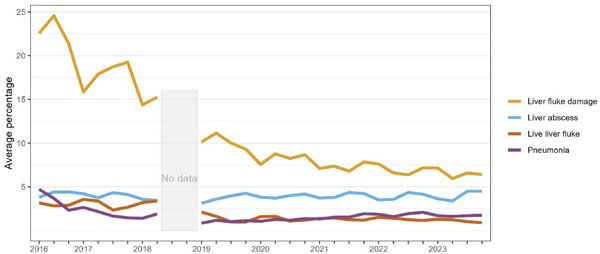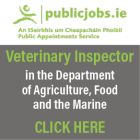Liver fluke trends in Ireland
Liver fluke is likely well known to practitioners in Ireland due to our grazing systems, rainfall and heavy soils. Natascha Meunier BVSc PhD DipECVPH, Beef HealthCheck Programme Manager, AHI, provides an update on the current status of liver fluke in Ireland
The high rainfall and warm summer has provided ideal conditions for liver fluke and its intermediate host to thrive this year. The DAFM Liver Fluke forecast has predicted a high risk of liver fluke for most of the country. Although in contrast, many parts of the country saw cattle entering housing earlier this season due to wet conditions underfoot which will lower their infection risk. Flukicides and pasture management, as well as farm-specific control plans, remain the mainstays for liver fluke control.
Epidemiology
Fluke parasites need an intermediate host to complete their life-cycle and in Ireland the mud snail Galba truncatula is considered the main host, although others have also been described. Rumen fluke also shares this snail host. Temperature and moisture are influential in the snail and fluke development, with wet soils and temperatures above 10°C needed for development. The life stages within the snail usually occur between May and October, with cercaria released onto pastures in autumn, when animals are again at high risk of infection. The encysted metacercaria stage can survive in cold and dry conditions and remain viable. Outwintered animals therefore remain at risk throughout winter if grazing on infected pastures.
When a large number of infective metacercaria are ingested, this can result in the acute presentation of disease – liver haemorrhage and sudden death – which is more common in sheep. Chronic fascioliosis is more typical in cattle and can lead to lack of thrive, reduced fertility, reduced milk yield and lower weight gains.

Table 1
Testing available
As liver fluke are large parasites, these are detectable at slaughter during the liver inspection. The Beef HealthCheck programme has been collecting health information at slaughter since 2016, making historical and current reports available to farmers, their veterinarians and advisors through ICBF (beefhealthcheck.icbf.com). For farms sending animals to slaughter at one of the participating factories, this is a convenient way to monitor if liver fluke is present on the farm.
Faecal egg examination uses sedimentation to isolate fluke eggs and some automated systems have recently added fluke egg detection capabilities. Faecal sampling is straightforward but the timing will influence the interpretation of the results considering the long fluke life cycle (10-12 weeks). If trying to determine the presence or absence of liver fluke on the farm, sampling later in the winter season (Jan-Mar) when egg-producing adults are expected to be present, is more likely to yield a positive result. Sampling before, and 14-21 days post-treatment, can be a useful indicator of treatment efficacy, provided adult liver fluke are present.
The coproantigen ELISA can be helpful to detect infection a number of weeks before eggs are seen in a faecal sample. This might be useful to guide optimal timing of treatment on farms with previous cases of acute fascioliosis. Serum or milk ELISAs are also available which detect antibody but are limited in distinguishing between current and previous infections. Repeated sampling will provide more useful information when using these tests.

Figure 1: Health conditions reported at slaughter as part of the Beef HealthCheck programme for 2016-2023.
Control
Fluke control, as with all antiparasitic treatment, should be tailored to the individual farm and adapted for the environmental or weather conditions. Flukicide treatments should target the expected life stage of the liver fluke parasite likely to be present (Table 1). Withdrawal periods for meat and milk should also be closely adhered to.
Given evidence of resistance to triclabendazoles1, these should be used sustainably and ideally kept for cases of prevention and control of acute fascioliosis, particularly in sheep. A product listing of antiparasitics marketed in Ireland for cattle or sheep is available for download on the AHI website (animalhealthireland.ie) summarising actives and target parasites.
Oxyclozanide also has reported activity against rumen fluke infection, although no products are licensed for use against this parasite in Ireland. Adult rumen fluke are tolerated fairly well and the immature parasites are primarily responsible for the clinical disease. Therefore, presence of eggs on faecal testing without clinical signs or a history of disease are not sufficient evidence for treatment. Clinical signs include diarrhoea, weight loss, anorexia, dehydration, anaemia or hypoalbuminaemia and typically affect sheep and first-grazing-season cattle. Research suggests that subclinical rumen fluke infection on well-managed farms does not compromise growth rates2. If larval rumen fluke infection is suspected, please specifically request this test when sending faecal samples for examination as routine parasite examination may not detect this stage of the parasite.

Figure 2: Percentage of positive samples for liver and rumen fluke faecal samples in cattle submitted to the RVLs in Ireland and AFBI, Northern Ireland.
Fluke trends
Initial results from the recently completed Parasite Control TASAH would suggest 32 per cent of cattle farms and 39 per cent of sheep farms consider liver fluke problematic. This is ranked third in comparison to lungworm (53 per cent) or PGE (41 per cent) for cattle farms and PGE (66 per cent) or flystrike (40 per cent) in sheep flocks. On slaughter examination as part of the Beef HealthCheck programme in 2023, 39 per cent of cattle herds had at least one animal presenting with damage due to liver fluke, while 12 per cent of herds had at least one animal slaughtered where live liver fluke parasites were seen (active infection). The within-herd prevalence is likely to be low, depending on the farm and region, as the animal level slaughter prevalence for liver fluke damage was 6.6 per cent and live active liver fluke infection was 1.1 per cent. Prevalence remains highest in the north-west counties.
This slaughter prevalence has been decreasing (Figure 1), particularly after the drought year of 2018 and has remained at low levels in recent years below 10 per cent for any sign of infection. Live active liver fluke infection was at three per cent prior to 2018 and since has remained at 1.1 to 1.3 per cent. This is in contrast to liver abscesses, also reported as part of the Beef HealthCheck programme, which have remained constant between 3.2 to 4.2 per cent.
Laboratory reporting of faecal samples from the Regional Veterinary Laboratories (RVLs) and AFBI, Northern Ireland, also show a decreasing trend in recent years for positive liver fluke eggs in bovine samples (All Island Surveillance Reports)3. The RVLs reported a decrease from 3.4 per cent to 1.6 per cent positive liver fluke samples in Irish cattle from 2018 to 2021 and from 36 per cent to 27 per cent of samples positive for rumen fluke over this four-year period. This would correspond to the decrease in liver fluke seen at slaughter. Decreases in faecal positives for liver fluke were also seen prior to 2018 from high levels in 2013, but this trend wasn’t seen in rumen fluke (Figure 2) or in sheep for either parasite (Figure 3) over the same period. This would imply that management or treatment factors may be driving these changes in liver fluke prevalence in cattle rather than environmental factors only, considering the shared intermediate snail host and non-specific final host of cattle or sheep.
It should be noted that neither slaughter prevalence nor laboratory faecal submissions reflect the true population prevalence, but that trends over time may be considered an indicator of the infection levels. Additionally, both post-mortem examination and faecal results would lag behind infection levels due to the delay between infection and slaughter, or infection and egg production respectively.

Figure 3: Percentage of positive samples for liver and rumen fluke faecal samples in sheep submitted to the RVLs in Ireland and AFBI, Northern Ireland.
Greenhouse gas emissions
It stands to reason that healthy animals will be more efficient in the production of meat and milk resulting in financial and emissions benefits. Veterinarians, therefore, have a crucial role to play in keeping animals healthy in an age when reducing emissions is a political and social focus. Reducing age at finishing, which relies on good fertility and health, was highlighted in the recent Teagasc MACC 20234 as a measure to target to meet our national climate commitments.
As an example of this efficiency, analysis of the Beef HealthCheck data has shown that, when other factors are accounted for, heifers and steers without evidence of liver fluke infection were on average 38 days younger at slaughter5. Similarly, heifers and steers without evidence of liver abscesses or pneumonia were, respectively, at least eight and 11 days younger at slaughter. Recent figures from Teagasc suggest that each day reduced from slaughter age of these animals reduces emissions of greenhouse gases by 5.6kg CO2e and contributes at least 70c to net margin – important gains given the current industry focus on sustainability.
- Mooney L., Good B., Hanrahan J.P., Mulcahy G., De Waal T. The comparative efficacy of four anthelmintics against a natural acquired Fasciola hepatica infection in hill sheep flock in the west of Ireland. Vet. Parasitol. 2009;164:201–205.
- Atcheson E., Lagan B., McCormick R., Edgar H., Hanna R. et al., 2022, The effect of naturally acquired rumen fluke infection on animal health and production in dairy and beef cattle in the UK. Frontiers in Veterinary Science. 2022 (9)
- All-Island Animal Disease Surveillance Report. 2010-2021. http://www.animalhealthsurveillance.agriculture.gov.ie/labreports/
- Lanigan G., Black, K., Donnellan T., Crosson P., et al. 2023. MACC 2023: An Updated Analysis of the Greenhouse Gas Abatement Potential of the Irish Agriculture and Land-Use Sectors between 2021 and 2030. Teagasc, Oak Park, Carlow. 353pp 2023 https://www.teagasc.ie/environment/climate-action/climate-centre/marginal-abatement-cost-curve-2023/
- Meunier NV., Graham, D., Gomes, C., 2022, Abattoir lesions in cattle are associated with an increased age at slaughter. Teagasc National Beef Conference 2022. https://www.teagasc.ie/media/website/publications/2022/Teagasc-National-Beef-Conference-2022-Web-Version.pdf
Liver fluke levels in cattle in Ireland in recent years have been…
A. Increasing
B. Decreasing
C. Remained stable
D. Decreased and then increased
2. Which of the following medications can be used to treat against adult liver fluke?
A. Triclabendazole
B. Clorsulon
C. Closantel
D. All of the above
3. Which of the following statements are true?
A. Liver fluke eggs are not distinguishable from rumen fluke eggs
B. Liver fluke eggs are routinely detectable by the McMaster technique
C. Liver fluke eggs are usually detected with sedimentation techniques
D. Liver fluke eggs develop into larvae before detection in the laboratory
4. Which of the following statements are false?
A. Roughly a third of Irish farmers consider liver fluke problematic on farm
B. Sheep liver fluke levels have been significantly decreasing in recent years
C. Animal level prevalence of liver fluke is likely very low in Ireland
D. Rumen fluke prevalence is higher than liver fluke prevalence in sheep and cattle
ANSWERS: 1B; 2D; 3C; 4B.








